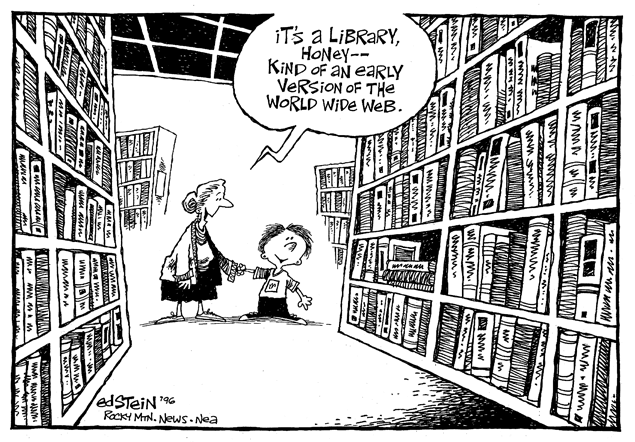I’ll have to admit that the idea of innovation is not something that interests me. I have never been suited for business and I am not the type of person who goes about trying to change things. I am stubborn, unable to move in my old ways. Of course, I will try out new and improved ways of doing things. But I am not creative in that way; I will not be the one doing the innovation.
The concept of innovation, therefore, is somewhat daunting. I think of imposing businessmen at long tables with a stammering, hopeful innovator standing at one end, about to pitch a new idea. It’s never appealed to me, which is precisely why I’ve never pursued any sort of business venture: it’s simply not for me.
However, all of this week’s readings revolve around innovation. For a while, I tried to see if there was a subject I could cherrypick from these articles in the hopes I wouldn’t have to pursue the idea of innovation as a blog post. Alas, this was not the case, and I am stuck here with a little imp called innovation jeering at me while I stare blankly at these pages.
My cautious approach to innovation is the idea of evolving in order to adapt to a increasingly technological society. After much consideration, I have smashed “innovation” and “library science” into one argument: a library must evolve to survive, or it will surely perish.

The modern teenager would have you believe that libraries are not useful anymore. After all, with a simple Google search, you can find all the information for a research paper you need, right? A visit to Wikipedia, and blammo, you’re done!
Wow, it’s so simple. I really wish someone had taught me that in undergrad! And here I was, spending hours vetting articles through JSTOR, Muse, or EBSCO. So silly–everyone knows that no one can lie on the internet.
Let’s take a little side trip here to show you a humorous example of lying on the internet, from this very amusing Tumblr post. According to this post, Tumblr user hullaballoons created a website about 6 years prior with falsified “facts” about President James Buchanan. Though it was not an official site whatsoever, many misguided and eager Googlers typed in “james buchanan facts” and stumbled across her site. It wasn’t just shared on social media; an author of a presidential trivia book took these entirely untrue statements as fact and published them.
Because, of course, nothing on the Internet can be a lie. You have to be qualified to post here. (Just don’t look at a comment section on YouTube anytime soon.)
Of course, anyone with any sense in their brains knows that there is a lot of false information floating out there on the Internet. If you were to browse books in a library on a certain subject, you can be sure that, most of the time, the books therein contain accurate information that you could use for a paper or presentation. But as more students procrastinate, few want to browse the bookshelves when they believe the Internet can give them the instant answers they need.
So librarians adapt. We give lectures to classes of incoming Freshman on how to search for accurate information. After all, that’s a major part our job – to be able to search for information for patrons so that their research needs are fulfilled. So, when they’re either too pressed for time or too nervous to approach us, we take the process to them. I remember I often hated sitting in those lectures during early English or History courses where a librarian would show us how to use a database, but I know that if I hadn’t known those search methods, there were many papers I would have never finished on time.
There are many who agree that library outreach is a necessary innovation. In an article on Public Libraries Online, Carolyn Anthony asserts that libraries must remain relevant by adapting to modern user’s needs:
Accepting the need for constant innovation will require that public libraries adopt a disciplined approach to turning outward toward the community to understand how the library can adapt to people’s changing lifestyles and patterns. It will also require that public libraries hire people who are creative, analytical, and social to engage with community residents, and to form partnerships with agencies staffed with workers having diverse skills who can work with us to help the community achieve its aspirations.
A cornerstone of library science theory is that libraries exist to suit users’ needs. What use is a library that sits pretty but isn’t accessible or worthwhile? Though it is an important repository for human knowledge, it also serves a greater purpose. When our users’ needs changes, so must our methods.
Perhaps the idea that libraries are outdated and backwards is a public relations issue. In an article on Shareable, Cat Johnson insists that libraries are evolving–and have been for quite some time. Within it, she cites evidence that librarians have embraced Internet since its widespread use, and it certainly makes sense once you stop to think about it. As information science professionals, why wouldn’t librarians learn to use online resources? For some reason, however, librarians have this bad rap of being obsessed with print and stuck in their old ways.
It’s hard to find any literature that argues against libraries, believe it or not. I was sure that I might find some sort of ultra-conservative rant about libraries being a waste of taxpayer money, but I was pressed to find such arguments. Instead, I found several rewarding arguments that posed the question, “Do we need libraries?” answered with resounding “YES!”s all around. Until, that is, I found one simple blog post from 21st Century Library:
. . . There is no adequate answer – yet.
Why is that? Why are we – the profession – unable to answer that fundamental question? Is it because there is no single answer that satisfies everyone? Is it because the answer is too big for non-librarians to understand? Is it because it is the wrong question that has no correct answer? Yes. Yes. and Absolutely!
When we look at what the library is evolving into today – the 21st Century Library – we can easily answer the “Why…?” question with a “We don’t.” answer. BECAUSE that tired old question is asking why we need the “classic” library, the 19th Century Library, the “collection of books” library, the librarian as “gate keeper” library. And the correct answer is WE DON’T!
We absolutely DO NOT need that tired old stereotype library with the bunned, shushing librarian guarding a dusty collection of “books.” Society has no use for those obsolete libraries and librarians of the past that were adequate for the society of the past.
I won’t share the entire post, though it’s certainly worth a read. Kimberly Matthews’s post cries out for a call to arms for libraries to adapt to the 21st century–and for users to see that libraries have embraced modern technology. Though the librarian stereotype of an old, angry woman “shushing” a patron from behind a stack of dusty books may ever prevail, we never need to stoop so low as to fulfill that social prophecy.
Libraries are better than that. Our users DESERVE better than that. And that is why innovation is an essential part of the future of library science.
